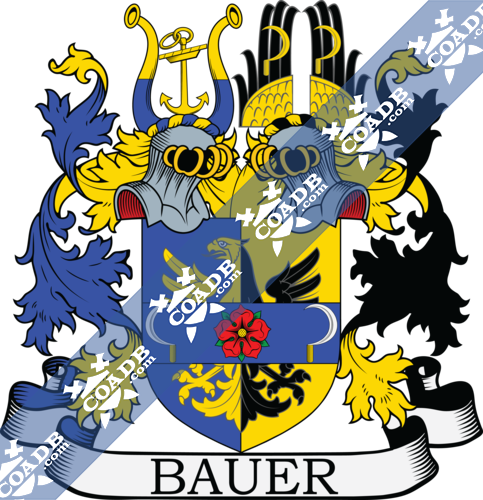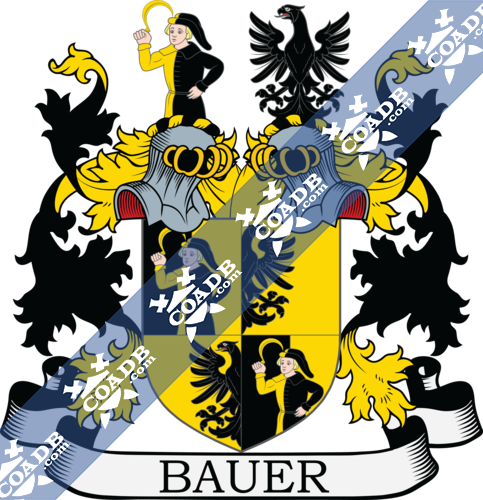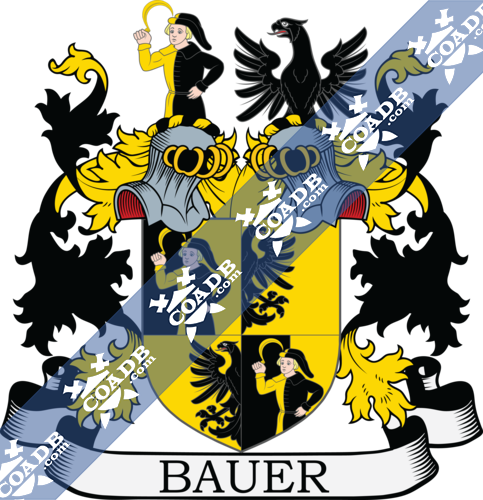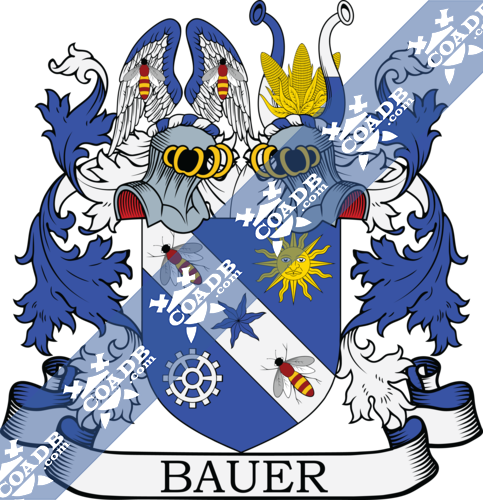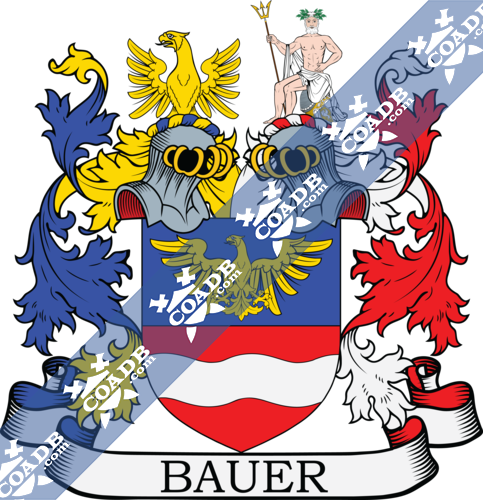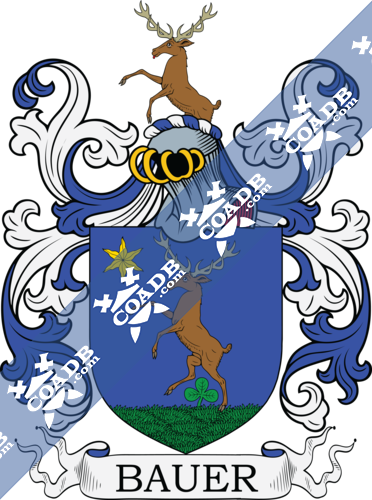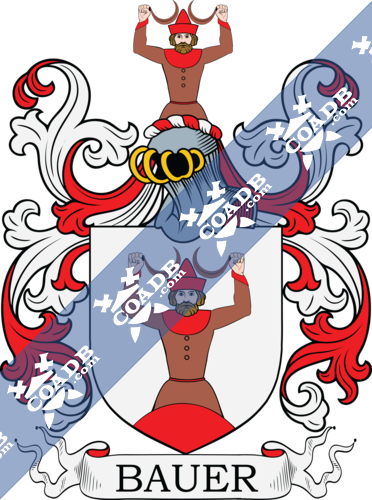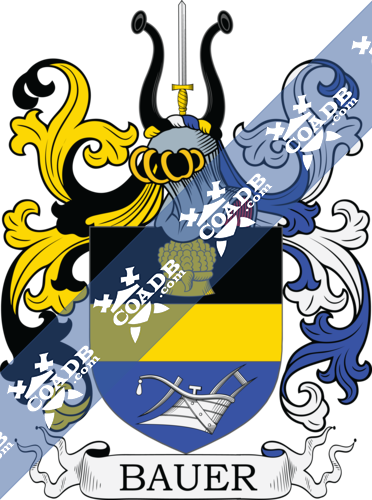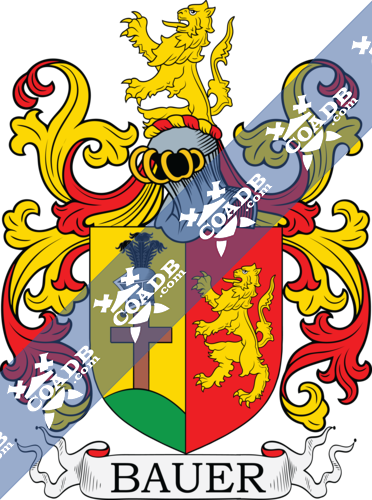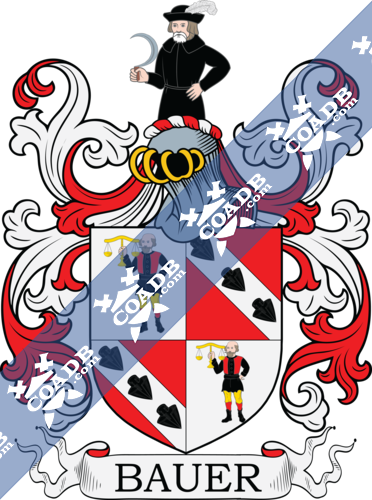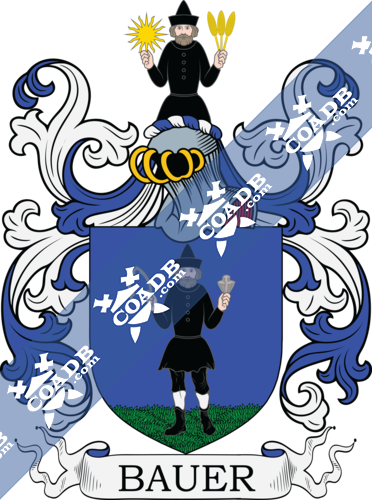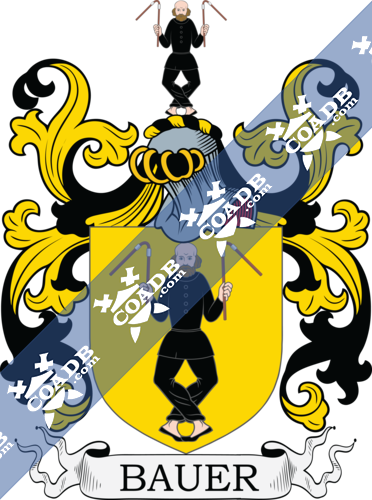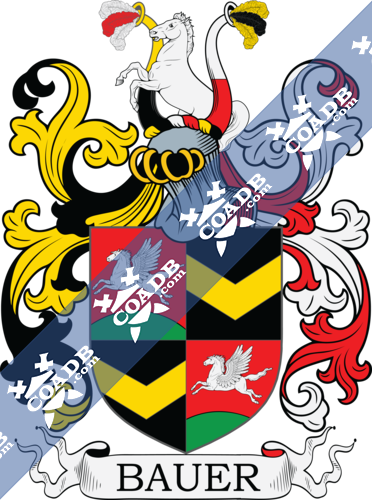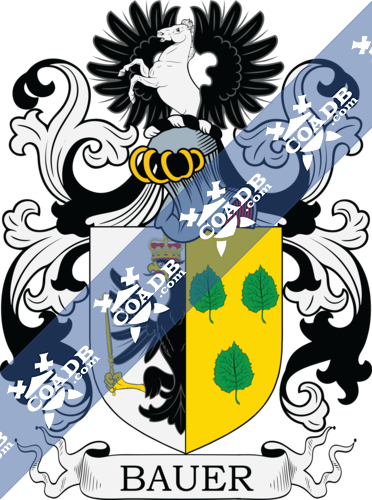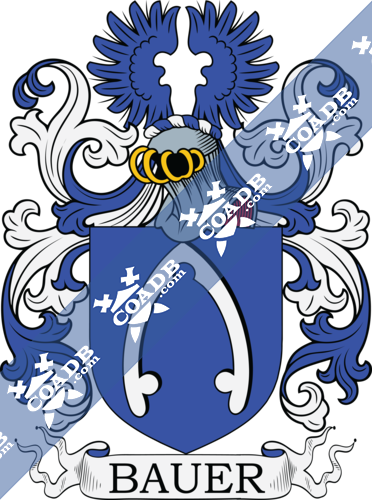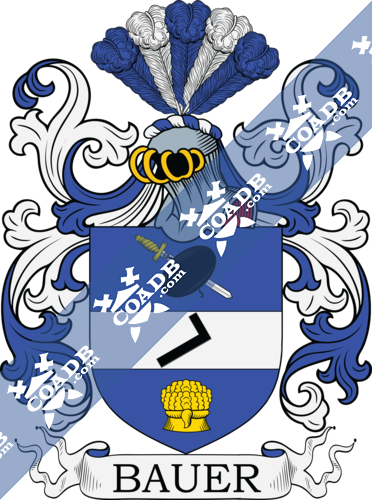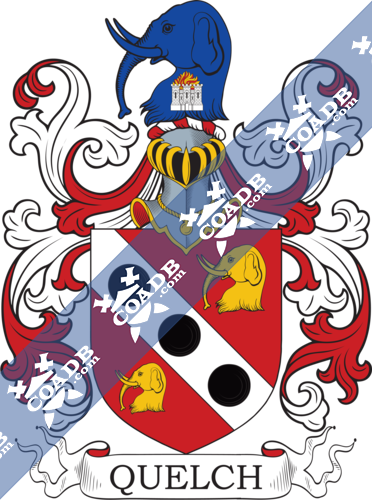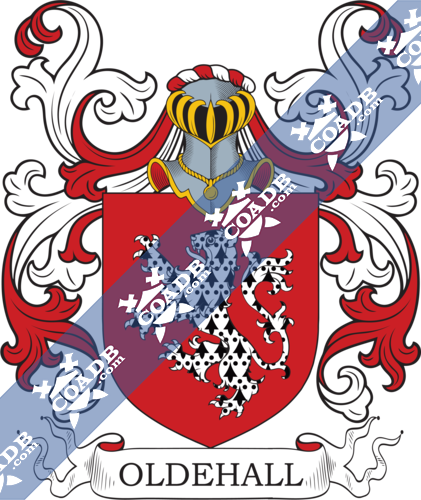Bauer Family Crest, Coat of Arms and Name History

Bauer Coat of Arms Gallery
Don’t know which Coat of Arms is yours?
We can do a genealogical research. Find out the exact history of your family!
Learn MoreOrigins, Meaning, History, & Etymology
This German, Austrian, and Danish surname means neighbor, fellow citizen, husbandmen, farmer or peasant. It comes from the Middle High German word bur, meaning the occupant of a small dwelling or house. In Old High German, the word buan means “to cultivate” or “to build”. Another source states it comes from the Old German word giburo. It is claimed that the name was first found in Austria and Denmark.
Spelling Variations:
Common spelling variants include Baur, Bauerr, Bohr, and others. The English equivalent is the surname Bower or Burr (from the Old English bur). The Swabian variants are Bauerle, Beuerle, Beyerle.
Popularity & Geographical Distribution
The last name Bauer ranked 484th in the United States according to the 2000 Census. In Germany, the surname ranked 14th in popularity in recent years. It is most prevalent in Bavaria. The name is also very prevalent in Austria, where it was ranked 3rd as of 2006. In the New World, it is common in Brazil, in addition to the United States. The name is also present in eastern Europe, such as in Slovenia, where it may be a translation of Kmet.
Early Bearers of the Last Name
The earliest known bearer of this surname was Johanne Bower of Greifswald, Germany, who was recorded in 1354 AD. A one Endres Bauer had a son named Anreas who married Ursula Meyher in 1587 in Neundorf, Germany.
Early Settlers to the New World
Some early settlers in the United States include Anna Margreet Bauer (New York 1709), Christian Bauer (1709), and Johann Christoph Bauer (Pennsylvania 1731). Some of the first people bearing this surname in Canada include John, Maria, Mergereta, and Andreas Bauer, who arrived in Nova Scotia in 1757.
Genealogy
A one Valten Bauer was born in Germany in 1435 AD. He died in 1520, but left a son, also named Valten. This Valten was born in 1460 in Neunford, Sachsen (Saxony). He had a son named Hannsen, who was born in 1485 in the same city. He was married in 1510 in Chemnitz and left the following issue: Andreas, Barthel, Hans, Toffel, Andreas, Vallentin, and Michael. Andreas Bauer was born in 1526. He left a son named Bernhard, who was born in 1534 in Baden-Wuerttemberg. He married Maria Agnes and they left the following children: Jacob, Agnes, Bernhard, Barbarba, Katherine, and Melchoir. His son Bernhard was born in 1574 in Dettenhausen. He married Regina Scheidle in 1601 and later Margaretha Loeffler in 1627. He had the following issue: Georg, Johannes, Margaretha, Regina, Melchoir, Agnes, Anne, Bernhard, and Martin. His son Melchoir was born in 1613 in Breitenstein, Germany and married Anna Stengel in 1632. Together they had several issue: Johann Adam, Bernhard, Anna, Johannes, and Woern. His son Johann Adam Bauer, also spelled Beyer, married Anna Maria Fuhrs Wiullheit and had numerous issue with her: Blasius Beyer, Christopher Beyer, Samuel Beyer, Anna Barbara Beyer, and Anna Klara Beyer.
William Bauer Sr. was born in Saxony German in 1820. He married Anna K. Rau and left the following issue with her prior to his death in 1909 in New York: William Jr., Henry, John, Benjamin, Frieda, Anne, Emil, Albert, and George. His son William Jr. was born in 1848 in New York and married Cornelia McKenzie in 1873. They had the following children: Anna, Emma, Charles, and May.
Arthur W. Bauer was born in 1893 in Wisconsin. He married Emilie Dombeck and they had two children together: Dorothy and Arthur L.
Motto:
Four family mottoes for the surname Bauer has been identified:1) Labore ad honorem, which means “By labor and honor”, 2) Origins memor, meaning “???”, 3) Integre et prudenter, meaning “Integrity and prudence”, and 4) Im glauben ruht die kraft, meaning “I believe in strength”.
Notables
There are numerous famous people bearing this surname, including, but not limited to: 1) Bruno Bauer (1809-1882) who was a German historian and philosopher who was a radical Rationalist, 2) Eddie Bauer (1899-1986) who was an American outdfoorsman, author, and businessman who founded a famous clothing brand, 3) Harold Bauer (1873-1951) who was a famous English pianist, and 4) Gustav Conrad Bauer (1820-1906) who was a German mathematician.
Blazons & Genealogy Notes
1) Nuremberg – D’or à l’arbre triplement étagé de sinople posé sur un tertre du même le champ chapé d’azur à deux lions affrontés d’argent Casque couronné Cimier une aigle de sable becquée et membrée d’or entre deux proboscides coupées alternativement d’argent et d’azur – Or a tree of three layers (levels) vert placed on a hillock of the same the field has a chape azure with two lions affrontant argent Crowned with a helmet Crest: an eagle sable beaked and legged or between two proboscides per fess alternately argent and azure.
2) Nuremberg – D’azur à un paysan habillé d’une veste d’un haut-de-chausses et de souliers et coiffé d’un chapeau le tout de sable les bas d’argent posé sur une terrasse au naturel les bras étendus tenant de sa main dextre un fer de bêche et de sa senestre un soc de charrue le tout au naturel Cimier le paysan issant supportant de sa main dextre un soleil d’or et empoignant de sa senestre trois épis effeuillés du même Lambrequin d’argent et d’azur – Azure a peasant dressed in a jacket, breeches and boots and wearing a hat all sable the hose argent placed on a mount proper the arms extended holding in the dexter hand the blade of a spade and in the sinister a ploughshare all proper Crest: the peasant issuant supporting in the dexter hand a sun or and grasping in the sinister three defoliated (leafless) heads of corn of the same Mantling: argent and azure.
3) Moravie – (Chevaliers, 29 déc. 1870) – D’azur à la bande d’argent ch d’une étoile du champ et de deux abeilles au naturel la bande acc en chef d’un soleil figuré d’or et en pointe d’une roue de moulin d’argent Deux casques couronnés Cimiers 1° un vol contourné l’aile de derrière d’azur l’aile devant d’argent ch d’une abeille volante au naturel en pal 2° trois épis d’or entre deux proboscides coupées alternativement d’azur et d’argent Lambrequin d’argent et d’azur Devise LABORE AD HONOREM – Azure a bend argent charged with an etoile of the field and two bees proper, the bend surrounded by in chief a sun with a face or and in base a mill wheel argent Crowned with two helmets Crest: 1st a pair of wings lowered the back of the wings azure the front argent charged with a bee volant proper in pale 2nd three heads of corn or between two proboscides per fess alternately azure and argent Mantling: argent and azure Motto- LABORE AD HONOREM.
4) Palatinat – Écartelé aux 1 et 4 de gueules au Pégase saillant d’argent soutenu d’un tertre de sinople aux 2 et 3 de sable au chevron renversé d’or Casque couronné Cimier un cheval issant d’argent entre deux proboscides coupées à dextre d’or sur sable à senestre d’argent sur gueules ornées chacune dans son embouchure de trois plumes d’autruche à dextre une de gueules entre deux d’argent à senestre une de sable entre deux d’or Lambrequin conformes aux émaux des proboscides – Quarterly 1st & 4th a pegasus flying argent above a hillock vert 2nd & 3rd sable a chevron inverted or Crowned with a helmet Crest: a horse issuant argent between two proboscides per fess to the dexter or over sable to the sinister argent over gules each decorated in the mouth with three ostrich feathers, in the dexter one gules between two argent and in the sinister one sable between two or Mantling: the same colours as the proboscides.
5) Vienne – (Chevaliers, 24 juillet 1881) – Coupé au 1 d’azur à l’aigle d’or au 2 de gueules à la fasce ondée d’argent Deux casques couronnés Cimiers 1° une aigle issante d’or Lambrequin d’or et d’azur 2° un dieu marin de carnation barbu ceint et couronné de roseaux assis sur la couronne du casque et tenant de sa main dextre un trident la senestre appuyée sur sa hanche Lambrequin d’argent et de gueules – Per fess 1st azure and eagle or 2nd gules a fess wavy argent Crowned with 2 helmets Crest: 1st an eagle issuant or Mantling: or and azure 2nd a sea god (Neptune) carnation bearded, with a crown of reeds sitting on his helmet and holding in the dexter hand a trident, the sinister resting on the hip Mantling: argent and gules.
6) Russie – (Nob. de Prusse, 1761) – Parti au 1 d’argent à la demi-aigle de Prusse mouv du parti au 2 d’or à trois feuilles de peuplier mal-ordonnées de sinople les tiges en bas Casque couronné Cimier un cheval issant d’argent entre un vol de sable Lambrequin d’argent et de sable – Per pale 1st argent a demi-eagle of Prussia coming from the pale 2nd or three poplar leaves (disordered) 1 and 2 vert the stems in base Crowned with a helmet Crest: a horse issuant argent between a pair of wings sable Mantling: argent and sable.
7) Rothenburg (Bavière) – D’azur à un fer de bêche d’argent Cimier un vol aux armes de l’écu – Azure the blade of a spade argent Crest: a pair of wings as the shield (azure).
8) Bavière – D’azur à la fasce d’argent ch d’une équerre de sable posée en barre la fasce acc en chef d’un bouclier ovale de sable brochant en barre sur une épée d’argent garnie d’or posée en bande et en pointe d’une gerbe d’or Cimier cinq plumes d’autruche alternativement d’azur et d’argent – Azure a fess argent charged with
9) Bâle – D’azur à la barre d’or bordée d’argent ch de trois fleurs-de-lis du même posées dans le sens de la barre à la bordure d’or Casque couronné Cimier un vol d’azur et d’or Lambrequin d’or et d’azur (V Baur d’Eysseneek) – Azure a bend or a bordure argent charged with three fleur-de-lys of the same placed bendwise sinister in the bordure or Crowned with a helmet Crest: a pair of wings or Mantling: or and azure (for V Baur d’Eysseneek).
10) (Edle von) – Bohême – (An., 7 oct. 1867) – D’azur à une ancre d’or chapé-ployé d’or ch à dextre et à senestre d’une demi-aigle de sable mouv du chapé au chef d’azur ch de trois abeilles d’or Casque couronné Cimier une étoile d’or entre un vol coupé d’or sur azur Lambrequin d’or et d’azur – Azure an anchor or a chape embowed (English equivalent “Tierced in Mantle”) or charged with to the dexter and to the sinister a demi-eagle sable coming from the chape a chief azure charged with three bees or Crowned with a helmet Crest: an etoile or between a pair of wings per fess or over azure Mantling: or and azure.
11) Coire – D’azur au cerf rampant au naturel soutenu d’une terrasse de sinople et un trèfle du même mouv de la terrasse au-dessous du cerf ledit cerf acc d’une étoile d’or posée au canton dextre du chef Cimier un cerf issant au naturel Lambrequin d’argent et d’azur – Azure a stag rampant proper standing on a mount vert and a trefoil of the same coming from the mount below the stag, the said stag accompanied by an etoile or placed in the dexter chief quarter Crest: a stag issuant proper Mantling: argent and azure.
12) Moravie – (Chevaliers, 15 août 1873) – Parti d’azur et d’or à l’aigle éployée d’or sur l’azur et de sable sur l’or à la fasce d’azur brochant sur le tout et ch d’une rose de gueules boutonnée d’or et barbée de sinople entre deux faucilles affrontées d’argent emmanchées d’or Deux casques couronnés Cimiers 1° une ancre d’or entre deux proboscides coupées d’or sur azur Lambrequin d’or et d’azur 2° un vol à l’antique l’aile de derrière d’or plein l’aile de devant de sable ch d’une faucille d’or Lambrequin d’or et de sable Devise ORIGINIS MEMOR – Per pale azure and or an eagle displayed or on the azure and sable on the or a fess azure covering overall and charged with a rose gules seeded or and barbed vert between two sickles affrontant argent handles or Crowned with two helmets Crest: 1st an anchor or between two proboscides per fess or over azure Mantling: or and azure 2nd a pair of wings (ancient) the back of the wings or (plain) the front sable charged with a sickle or Mantling: or and sable Motto- ORIGINIS MEMOR.
13) Fribourg-en-Brisgau – D’argent à un homme issant habillé d’une tunique brune au rabat de gueules ceint et rebrassé du même coiffé d’un bonnet pointu de gueules et mouv d’un tertre du même les bras levés tenant de chaque main une faucille de sable le tranchant du second vers senestre Casque couronné Cimier l’homme (moins le tertre) Lambrequin d’argent et de gueules – Argent a man issuant dressed in a brown foldover tunic gules belted and cuffed of the same on his head a pointed (woollen) hat gules and coming from a hillock of the same, the arms raised holding in each hand a sickle sable the blade of the 2nd facing sinister Crowned with a helmet Crest: the man (without the hillock) Mantling: argent and gules .
14) Francfort-s/Main – De sinople au vol d’azur au chef du même ch de trois étoiles d’or – Vert a pair of wings azure a chief of the same charged with three etoiles or.
15) de Bauer – Belgique – (Inc. dans la nob. belge avec le titre de chevalier, 20 avril 1885) – Écartelé aux 1 et 4 parti de sable et d’or à un jeune homme issant à la chevelure blonde habillé ceint et coiffé d’un chapeau le tout de l’un en l’autre tenant une faucille d’or de sa main dextre levée la senestre appuyée sur sa hanche aux 2 et 3 d’or à la demi-aigle de sable languée de gueules mouv du parti Cimiers 1° le jeune homme issant 2° une aigle de sable languée de gueules Lambrequin d’or et de sable Devise INTEGRE ET PRUDENTER – Quarterly 1st & 4th per pale sable and or a young man issuant with fair hair, belted and wearing a hat all counterchanged holding a sickle or in his raised dexter hand, the sinister hand resting on his thigh 2nd & 3rd or a demi-eagle sable langued gules coming from the pale Crest: 1st the young man issuant 2nd a eagle sable langued gules Mantling: or and sable Motto- INTEGRE ET PRUDENTER.
16) de Bauer – (Chevalier) – Bruxelles – Écartelé aux 1 et 4 parti de sable et d’or au jeune homme issant à la chevelure blonde habillé ceint et coiffé d’un chapeau le tout de l’un en l’autre tenant une faucille d’or de la main dextre levée et ayant la senestre appuyée sur la hanche aux 2 et 3 d’or à la demi-aigle de sable languée de gueules mouvant de trait de l’écartelure Timbre deux heaumes couronnés Cimier à dextre le jeune homme de l’écu à senestre une aigle de sable languée de gueules issante Devise INTEGRE ET PRUDENTER – Quarterly 1st & 4th per pale sable and or a young man issuant with fair hair dressed, girdled and with a hat all counterchanged holding a sickle or in the raised dexter hand and having the sinister hand resting on the thigh 2nd & 3rd or a demi-eagle sable langued gules coming from the line of the quartering Crowned with two helmets Crest: to the dexter the young man of the shield to the sinister an eagle sable langued gules issuant Motto- INTEGRE ET PRUDENTER.
17) de Bauern – Saxe, Prusse – (Nob. du St.-Empire, 29 mars 1775) – Coupé de sable à une gerbe d’or sur azur à une charrue d’argent à la fasce d’or brochant sur le coupé Cimier une épée d’argent garnie d’or posée en pal entre deux proboscides de sable Lambrequin à dextre d’or et de sable à senestre d’argent et d’azur – Per fess sable a garb (wheatsheaf) or over azure a plough argent a fess or covering over the partition Crest: a sword argent hilt and pommell or place in pale between two proboscides sable Mantling: to the dexter or and sable to the sinister argent and azure.
18) de Bauernthal – Autriche – (An., 17 mai 1870) – Parti au 1 d’or à une croix latine de bois posée sur un tertre de sinople et sommée d’un casque de tournoi au naturel panaché de trois plumes d’autruche de sable au 2 de gueules au lion d’or Casque couronné Cimier un lion issant d’or Lambrequin d’or et de gueules Devise IM GLAUBEN RUHT DIE KRAFT – Per pale 1st or a latin cross of wood placed on a hillock vert and surmounted by a tournament helmet proper topped by three ostrich feathers sable 2nd gules a lion or Crowned with a helmet Crest: a lion issuant or Mantling: or and gules Motto- IM GLAUBEN RUHT DIE KRAFT.
19) de Breitenfeld – Bavière – (An., 19 avril 1781) – Écartelé aux 1 et 4 d’argent à un paysan la tête nue habillé d’une veste et de souliers de sable d’un gilet et de bas de gueules d’un haut-de-chausses d’or tenant de sa main dextre une balance aux 2 et 3 de gueules à la bande d’argent ch de trois socs de charrue de sable posés dans le sens de la bande Casque couronné Cimier un homme issant habillé de sable coiffé d’un chapeau du même sommé d’une plume d’argent tenant de sa main senestre étendue une faucille au naturel Lambrequin d’argent et de gueules – Quarterly 1st & 4th argent a peasant the head bald dressed in a jacket and boots sable a waistcoat and hose gules, breeches or holding in the dexter hand a scale 2nd & 3rd gules a bend argent charged with three ploughshares sable in bend Crowned with a helmet Crest: a man issuant dressed sable with a cap of the same surmounted by a feather argent holding in the sinister hand extended a sickle proper Mantling: argent and gules.
20) de Loeben – Allemagne – D’or à un paysan posé de front la tête nue habillé de sable les jambes croisées en sautoir tenant de chaque main un fléau en pal Cimier le paysan Lambrequin d’or et de sable – Or a peasant facing the front the head bald dressed sable the legs crossed in saltire holding in each hand a flail in pale Crest: the peasant Mantling: or and sable.

